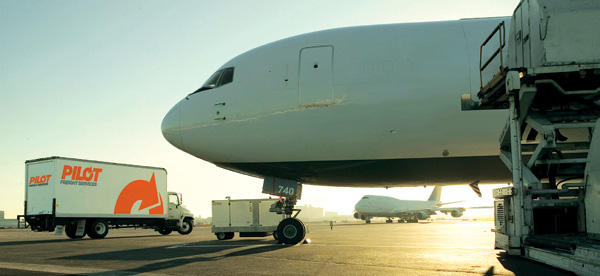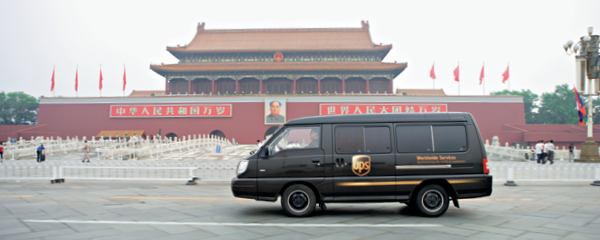Expedited Transport: It’s All in the Timing

Once cost-prohibitive for all but the most time-sensitive rush deliveries, today’s expedited services help shippers balance their need for speed with cost-effective solutions.
Delivery windows may vary, but expedited transportation providers serve a host of shippers whose need for speed renders regular, scheduled services inadequate. While the word expedited may bring to mind urgent, last-minute transportation, shippers often are turning to expedited service as part of their supply chain strategy, and not just because of their products’ properties.
Speeding Cell Phones to Market
Kencoil Counts on Next Flight Out
Celebrating Expediency
Expedited service is increasingly acting as a supply chain problem-solver. Its ability to deliver benefits such as lowering inventory carrying costs and adding flexibility to production planning can sometimes negate the higher cost. Logistics service providers are enabling this trend by creating a range of new options, from expedited ocean to two-driver ground services. “Any solution that cuts the transit time from origin to destination is an expedited business model,” says Cameron Holzer, president of team-driver truckload carrier CRST Expedited, based in Cedar Rapids, Iowa.
Traditionally, certain industries were established users of expedited services because they ship perishable items such as fresh fish, pharmaceuticals, and medical tissue samples. Critical documents and parts are also sometimes considered urgent.
Today, however, the list of products routinely shipped via expedited transportation has expanded considerably. Expedited services are now being used for e-commerce, seasonal and fashion goods; high-tech products; laboratory specimens; produce; energy; and manufacturing materials.
More shippers are using expedited because it has evolved from its days as a super-premium service. Expedited air and ground carriers have discovered opportunities to offer services that help shippers balance speed and cost. For example, in early 2011 UPS began offering a Preferred Less-Than-Containerload (LCL) service from Asia to the United States. The service currently includes 26 Asian ports, and can be faster than traditional ocean service, and less expensive than air freight.
UPS collects cargo from shippers’ suppliers in Asia, then consolidates it with regular LCL shipments for sailing. After arriving at a West Coast port, Preferred LCL shipments move through the same expedited UPS North American ground network used for airfreight shipments, trimming eight to 16 days from typical transit times for East Coast deliveries. The service, which uses a simplified zone pricing matrix, has experienced a 40-percent increase in shipments over the course of one year, and may expand to Mexico.
Right on Schedule
Another example is AirNet Cargo Charter Services’ Scheduled Package Delivery, which allows shippers to book expedited, scheduled charter service at about 60 percent less than the cost of a standard charter. Columbus, Ohio-based AirNet finds other shippers to share the flight, and the anchor shipper gets a share of the revenue.
Less-than-truckload (LTL) service providers are also stepping up their expedited game. YRC Freight, an LTL carrier based in Overland Park, Kansas, recently optimized its network to require fewer touches and cut at least one day of transit time in hundreds of lanes. New load plans and distribution center guides ensure its expedited, time-critical cargo is tail-loaded and processed quickly. The company also facilitates expediting by enabling shippers to simply indicate the service desired on the shipment’s bill of lading, as an alternative to regular booking processes.
These services give shippers new options amidst a general trend toward mode shifting, driven by issues such as high costs and fuel surcharges, heightened security requirements, reduced capacity, and delays and congestion.
“Every transportation and supply chain manager is trying to mode-shift,” says John Hill, executive vice president of sales for freight forwarder Pilot Freight Services, Lima, Pa. “If they’re using two-day service, they want three- to five-day. If they’re using next-day, they want second day.” Yet their urgency doesn’t change, making new expedited offerings a welcome development.
For many shippers, a guaranteed delivery time is a major benefit of expedited. Retail suppliers must hit tight delivery windows; the additional cost of an expedited service with a guaranteed delivery time can easily offset the cost of chargebacks for missing a delivery promise.
Shippers also frequently need expedited service to coordinate with promotions or speed time-sensitive goods to market for seasonal pop-up stores, trade shows, or sporting events. Demand for championship-themed sports merchandise, for example, rapidly fades from its peak immediately after the win. Knowing when the goods will arrive is paramount.
“The more consistent delivery we provide, the more the mode becomes invisible,” says Andy Huckbody, vice president of UPS Ocean Freight.
Expedited services also tend to involve more people and fewer touchpoints, so delicate or sensitive items receive better handling. In some sectors, such as electronics, shipping cartons are displayed on the store floor and cannot show the wear and tear of travel. “Consumers want a pristine package,” notes Hill.
Many businesses combine truck and air transport services provided by carriers such as Pilot Freight Services to ensure delivery of time-sensitive shipments.
Expedited Evolves
New expedited services also have a profound effect on shippers’ supply chains.
“For many shippers, using expedited has become a planned event rather than an emergency solution,” says Rick Mathews, vice president of expedited services and customer service, YRC Freight. Shippers can spend more time on processes such as analyzing the latest demand signals to shape production, or take extra care with quality control, knowing they can expedite delivery.
“Shippers may pay more, but the savings from the larger supply chain window exceeds the cost,” he adds.
Another factor is inventory carrying costs. The faster a product gets to the marketplace, the less time it spends on the books. “Shippers need to evaluate slower transit times and their impact on inventory carrying costs,” advises Huckbody.
He cites one recent expedited move that makes the math quite clear. A 250,000-pound part from a nuclear reactor in Portland, Ore., needed to be delivered to Charlotte, N.C., for service. It cost $1 million each day the reactor was down waiting for the part. The time saved offset the $400,000 cost to charter a plane for the move instead of going over the road.
In addition to bolstering just-in-time inventory strategies, expedited service helps support replenishment strategies when goods prove to be big sellers. CRST Expedited has seen increased demand for shipments moving directly from ports to customer locations, although most of its full truckload shipments still move through distribution centers.
“Some shippers use UPS Preferred LCL service to feed their supply chains weekly,” says Huckbody. “They have multiple preferred LCL shipments from various origins, and suppliers that are not big enough for full containers but need expedited shipping.”
UPS Preferred Less-Than-Containerload service collects cargo from shippers’ suppliers in Asia, then consolidates it with other LCL shipments for sailing. After arriving in the United States, the freight moves through the UPS ground network for delivery.
That arrangement works particularly well when shippers have new suppliers or locations to support. Shippers embracing the service include those in the industrial, automotive, consumer products, and high-tech industries.
Regulation is also driving increased use of expedited. In the past, shippers could recognize revenue from a sale by shipping it, but the Sarbanes-Oxley Act of 2002 requires that a shipment be received and signed for by the customer. Pilot has experienced an uptick in expedited shipments at quarter- and year-end, as a result.
Shippers continue to expect freight status visibility, particularly for urgent cargo. Carriers are complying by investing in technology.
For example, in July 2012, Southwest Airlines Cargo, based in Dallas, introduced wireless asset-tracking devices that monitor cargo location, shock, light, temperature, pressure, and humidity during transit. The devices collect data every 10 seconds, but can only transmit when on the ground. Cargo airlines typically permit customers to embed these devices, but don’t provide them.
The service has appealed to shippers of high-value life science products and perishables, who use the environmental data to ensure they are properly packaging future shipments for in-flight conditions.
Location tracking has also been a draw for the new service. “Some shippers have not been able to use any commercial passenger carrier because robust tracking data was not available,” says Wally Devereaux, director of sales and marketing for Southwest Airlines Cargo. “The devices allow us to provide that capability.”
On the ground, shippers are asking for more frequent shipment location and delivery updates to accommodate just-in-time inventory strategies, prompting carriers to build in additional checkpoints.
Unfortunately, shipper expectations about technology sometimes exceed their own capabilities. “Service providers are willing to offer extensive IT resources,” says Hill. “The challenge is getting shippers to dedicate resources to logistics and transportation, so they can receive and act on information such as tracking alerts.”
AirNet is considering RFID to perform functions such as tracking location, performance, and execution; creating manifests; and controlling routing.
“When you add an RFID tag in the package, and readers to the network, you can achieve impressive results,” says Frank DiMaria, senior vice president of sales and marketing at AirNet. For example, a pilot can instantly confirm that the loaded cargo agrees with the manifest, and ensure routing errors are corrected before they occur.
Expedited Enhances Security
Expedited freight equates to urgency, and some shippers view security processes as an obstacle to speed, particularly for air cargo. While some air carriers have devoted considerable effort to streamlining security processes, other expedited modes often tout their ability to move goods without the known shipper lists, screenings, and associated earlier cutoffs required for passenger airlines accepting cargo since the terrorist attacks of Sept. 11. Cargo-only modes also have more latitude to move certain sensitive goods. AirNet, for example, is authorized to handle radiopharmaceuticals.
Shippers are growing increasingly sensitive to the processes and conditions their expedited shipments will experience as they move through the supply chain. Shipments may require features such as cameras, access control, and cleanliness and handling process guidelines. Pilot is investing in equipment so it can perform security screening, build its own containerloads, and co-mingle freight before tendering it to air carriers.
In fact, the transit speed, reduced touchpoints, controlled networks, and extra personnel often associated with expedited services inherently enhance security. CRST Expedited adds to those benefits by putting two drivers in its trucks. This not only enables faster delivery times because the vehicle can always be moving, but also allows someone to be in the truck even when it is stopped, reducing theft risk. The company added an expedited Temperature-Controlled Team Service to extend the same parameters to perishable goods.
Getting the Best of Expedited
Carriers are crafting niche expedited services when they see an opportunity to fill unmet shipper needs. For shippers, it pays to carefully examine providers’ offerings to ensure a fit—and speak up when it’s not quite right. Here are some strategies to find the right expedited solution:
- Collaborate with carriers. “Shippers who allow full transparency receive the best results from expedited services,” says Hill. “They need to tell providers about their business, customers, and locations, so they can develop the best solution.”
- Make your own assessment of expedited services. Marketing materials, industry ratings, and checklists are not enough. More shippers are making the effort to evaluate expedited carriers’ facilities and operations firsthand to ensure proper conditions for their critical goods. Be aware that industry data can sometimes be deceiving. For example, the U.S. Department of Transportation’s Compliance, Safety, Accountability scoring evaluates CRST Expedited’s two-driver model by the same method as solo-driver carriers, giving potential users a false impression of the drivers’ efficiencies.
- Base vendor selection on your specific lanes and needs. Overall performance is immaterial if the expedited carrier doesn’t demonstrate a strong track record in the lanes or services your company uses. Know your key performance indicators, and build them into contracts.
By using new technical capabilities, meeting evolving market conditions, and taking a creative approach to combining services, expedited transportation providers are continually developing new solutions to meet shippers’ need for efficient and cost-effective expedited services.
Speeding Cell Phones to Market
Cell phone sales are all about the latest technology. Even when a particular model fails to catch on with the customers of major carriers such as AT&T and Verizon, distributors snatch up leftover lots from the manufacturer or carrier and sell the phones to others—typically smaller carriers serving rural regions. But before they can re-enter the market, the phones need new software, branding, and packaging.
That’s where Conversa Solutions comes in. The four-year-old Auburn Hills, Mich., company performs those services on the distributor’s behalf, then ships the phones directly to the distributor’s customers, such as rural carriers. Time is of the essence. “Rural carriers are eager to get the latest Verizon technology, even if it is six months old,” says Robert Reed, Conversa CEO and president.
Conversa plans its operations to perform much of the work early in the week, then turns shipments over to YRC Freight’s Time-Critical Service. Because the service moves on weekends, it can pick up shipments on Friday, then deliver them on Monday to many of Conversa’s customers.
For those farther away, Conversa aims to ship on Thursday for Monday delivery. “Our customers are often surprised when they receive shipments the next business day,” Reed says. The cost is comparable to regular LTL service, and much less than the second-day air otherwise required to meet those parameters.
Because the shipments are high-value, Conversa works with YRC to meet customers’ security requests, from palletizing and black shrink-wrapping, to dividing out trailers and locking down shipments until the customer breaks the seal.
Kencoil Counts on Next Flight Out
Productivity takes a huge hit when machinery goes down. That’s why industries such as electric power generation, petrochemical refining, and paper and pulp depend on Kencoil, Belle Chasse, La., to quickly manufacture custom electric motor coils that get equipment back in action. And that’s why Kencoil relies on expedited shipping—typically air—to move those coils to customers as fast as possible.
“We run 24/7,” says Derrick Gervais, Kencoil’s materials supervisor. “If a shipment is ready at 3 a.m., we take it to the airport.”
Kencoil, which serves manufacturing and repair facilities across the United States, as well as in Central and South America, includes in its fees the cost of shipping to the closest major airport, where customers either meet the flight or arrange courier service to their facilities. That makes it critical that customers have full visibility to their shipments; no one wants to wait at the airport for hours.
“Customer expectations about shipment tracking have increased,” Gervais says. “They need to know their shipment status so they can line up a crew, even late at night.”
Speed, reliability, and careful handling are also essential to deliver the heavy, but delicate, copper coils to their destinations. Kencoil typically relies on passenger airlines, primarily Southwest Airlines Cargo. To accommodate the carrier’s 200-pound-per-carton weight limit, Kencoil breaks orders into multiple packages, and surrounds the coils with spray foam and tubes to protect them during transit.
That protective packaging makes shipment tracking all the more challenging. Because a single order may comprise as many as six cartons, a shipment could be divided among routes.
Gervais credits Southwest with adapting quickly to meet these types of shipping challenges. “Build relationships with the expedited carriers you use,” he advises. “Know their processes and limitations. The more your carrier understands, the better it can meet your needs.”
Celebrating Expediency
Creating excitement around its product line lies at the core of direct-seller Celebrating Home’s business model. The company unveils a new catalog two to three times each year. When its 40,000 independent agents’ sales events begin, it is critical to get products to customers as quickly as possible. The company promises to deliver products within nine days of ordering.
Each catalog issued by Marshall, Texas-based Celebrating Home features about 750 products, from small furniture to in-home décor items, sourced from a variety of suppliers throughout Asia. The company primarily ships full containerloads of new products to its 600,000-square-foot distribution center in Marshall two to three months before a new catalog launches. It then ships all products directly to customers.
As it was preparing for a recent sales rally in Dallas, Celebrating Home needed 10 samples of about 50 new products, coming from 15 to 20 different manufacturers in Asia. The company decided to try the new UPS Preferred LCL service.
“In the past, we were forced to ship these products via air freight to receive them in time,” says Tom Walburgh, former director of supply chain management for Celebrating Home. “In this case, UPS Preferred LCL fit our needs because we were shipping smaller quantities, not full containers. Additionally, we were working under a tighter timeframe than usual—but not so tight that we needed to use air freight.”
UPS collected the shipments directly from vendors, transported them to the port, and ultimately delivered them to Celebrating Home’s corporate office. The items arrived in three weeks, versus the four it would have taken via standard service, at an estimated 50- to 75-percent savings over air freight.
“Going forward, we are examining the continual use of Preferred LCL for items that need to be expedited, but do not require the speed of air freight,” Wallburgh says. “This could prove particularly useful for products that sell better than anticipated and require restocking in a hurry.”


